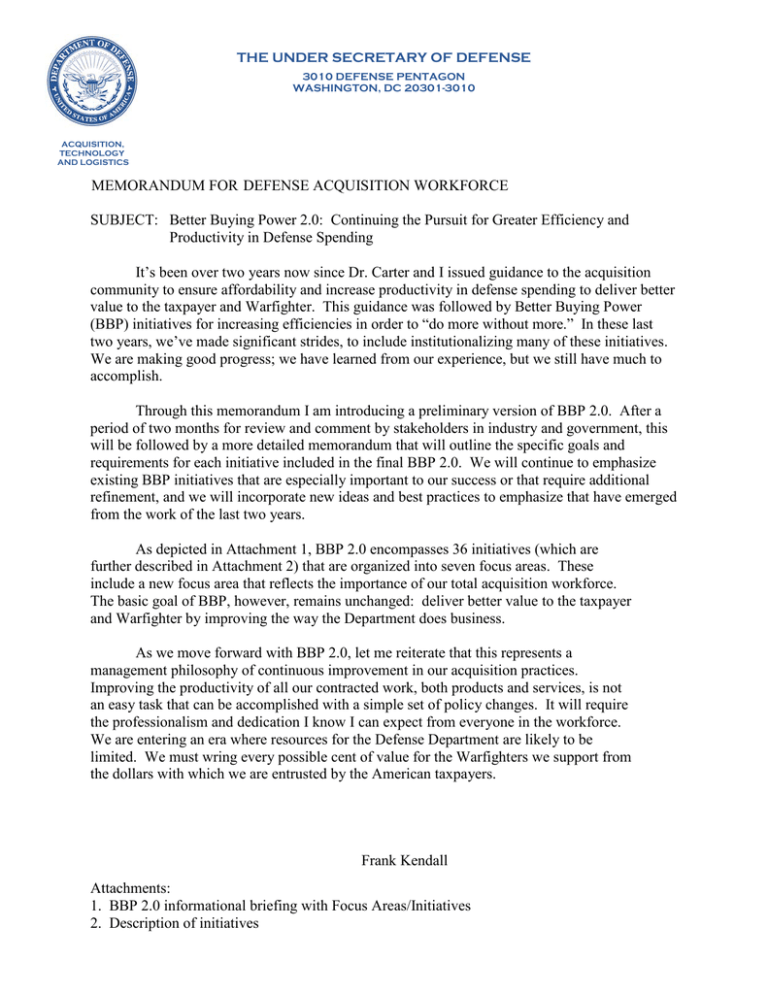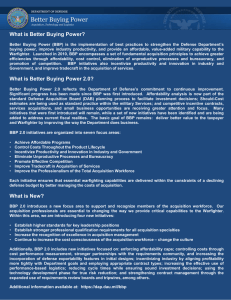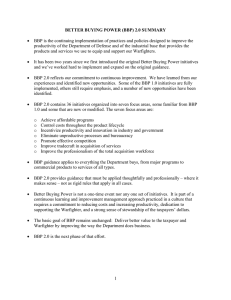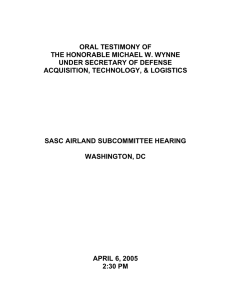MEMORANDUM FOR DEFENSE ACQUISITION WORKFORCE
advertisement

THE UNDER SECRETARY OF DEFENSE 3010 DEFENSE PENTAGON WASHINGTON, DC 20301-3010 ACQUISITION, TECHNOLOGY AND LOGISTICS MEMORANDUM FOR DEFENSE ACQUISITION WORKFORCE SUBJECT: Better Buying Power 2.0: Continuing the Pursuit for Greater Efficiency and Productivity in Defense Spending It’s been over two years now since Dr. Carter and I issued guidance to the acquisition community to ensure affordability and increase productivity in defense spending to deliver better value to the taxpayer and Warfighter. This guidance was followed by Better Buying Power (BBP) initiatives for increasing efficiencies in order to “do more without more.” In these last two years, we’ve made significant strides, to include institutionalizing many of these initiatives. We are making good progress; we have learned from our experience, but we still have much to accomplish. Through this memorandum I am introducing a preliminary version of BBP 2.0. After a period of two months for review and comment by stakeholders in industry and government, this will be followed by a more detailed memorandum that will outline the specific goals and requirements for each initiative included in the final BBP 2.0. We will continue to emphasize existing BBP initiatives that are especially important to our success or that require additional refinement, and we will incorporate new ideas and best practices to emphasize that have emerged from the work of the last two years. As depicted in Attachment 1, BBP 2.0 encompasses 36 initiatives (which are further described in Attachment 2) that are organized into seven focus areas. These include a new focus area that reflects the importance of our total acquisition workforce. The basic goal of BBP, however, remains unchanged: deliver better value to the taxpayer and Warfighter by improving the way the Department does business. As we move forward with BBP 2.0, let me reiterate that this represents a management philosophy of continuous improvement in our acquisition practices. Improving the productivity of all our contracted work, both products and services, is not an easy task that can be accomplished with a simple set of policy changes. It will require the professionalism and dedication I know I can expect from everyone in the workforce. We are entering an era where resources for the Defense Department are likely to be limited. We must wring every possible cent of value for the Warfighters we support from the dollars with which we are entrusted by the American taxpayers. Frank Kendall Attachments: 1. BBP 2.0 informational briefing with Focus Areas/Initiatives 2. Description of initiatives BETTER BUYING POWER 2.0 INITIATIVES DESCRIPTIONS Achieve Affordable Programs • Mandate affordability as a requirement: The initiative to provide affordability caps for unit production cost and sustainment costs was put in place two years ago and will continue. Affordability caps force prioritization of requirements, enabling cost trades and ensuring that programs which are currently too expensive in future budgets to be affordable from continuing. • Institute a system of investment planning to derive affordability caps: This has been implemented on a case-by-case basis as programs have entered the acquisition process. This initiative will make long-term capital investment analysis covering product lifecycles of 30 or 40 years a standard part of the acquisition process under DoDD 5000.02. Service and component resource managers and leadership will conduct portfolio analysis to limit future investment limitations on a capital investment portfolio of products, e.g., ground combat vehicles or surface combatants. • Enforce affordability caps: After two years of imposing affordability caps, we are now at the point where this initiative will have to be enforced if it is going to be successful at preventing spending on products that will be too expensive to be procured in meaningful quantities. This task falls to senior leadership, including the DAE, SAEs, and CAEs, who must work with the Service and Component leadership to halt programs that will not be within the established cap unless tradeoffs to reduce cost are implemented. Unless this is done, the Department will continue to spend billions on development and initial production of programs that are ultimately canceled or curtailed. Control Costs Throughout the Product Lifecycle • Implement “should cost” based management: Should cost, the concept that our managers should set cost targets below independent cost estimates and manage with the intent to achieve them, is well on its way to becoming part of the DoD culture. This effort is fundamental to cost control and deserves continued emphasis. Proactively controlling cost is everyone’s business. Savings will continue to be applied as close to their origin as Service and Department priorities allow. Successful should cost management should be recognized and rewarded by the chain of command and by personnel systems. • Eliminate redundancy within Warfighter portfolios: Duplicate or redundant efforts occur at the program level due to constraints in the component requirements process. The Department will identify synergies for existing and planned programs across the Services during MDD reviews, Program Budget Reviews (PB build), and across all levels of the buy. • Institute a system to measure the cost performance of programs and institutions and to assess the effectiveness of acquisition policies: The Department will become more datadriven in assessing its own and industry’s performance at achieving improved productivity. The Department will develop metrics for the programs and institutions (government and nongovernment) within the acquisition system and assess performance to better understand best practices in industry and government. The first set of data derived from this initiative will be published in early 2013. 2 • Build stronger partnerships with the requirements community to control costs: This is an area of continuing emphasis in which good progress has been made, but more needs to be done. More than anything else, requirements drive costs. The requirements and acquisition communities must cooperate more closely and continuously to ensure that requirements are technically achievable and affordable so that operational and Service leadership can make informed decisions about the costs associated with varying levels of performance. For Major Programs, the DAE is working closely with the VCJCS and the JROC, and each Service has taken steps in the right direction. However, more needs to be done to ensure well informed requirements decisions that balance cost and performance throughout product lifecycles. • Increase the incorporation of defense exportability features in initial designs: Foreign sales of and cooperation on US defense products provide a range of win-win benefits: reduced costs, improved US competitiveness, stronger ties to friends and allies, and improved interoperability. Rather than waiting until products are fully designed and in production for US use, we should assess and incorporate exportability design features and any needed anti-tamper features early in the acquisition process. This will reduce the cost of exportable versions of US systems and ensure that they are available for sale sooner, benefiting all concerned. Incentivize Productivity & Innovation in Industry and Government • Align profitability more tightly with Department goals: The Department will reassess how it provides incentives to industry so that they are as cost effective as possible at achieving the Department’s goals. The desire is to reward successful contractor performance that has high value to the Department and which might not be achieved without the motivation provided by the incentives. Both basic contract types and special incentive fee structures will be reassessed over the next few months to see if a better alignment can be accomplished. • Employ appropriate contract types: The original BBP emphasized the use of Fixed Price Incentive (FPI) contracts. In BBP 2.0, we are refining our guidance to emphasize the use of the appropriate contract vehicle for the product or services being acquired. The DFAR and FAR provide for a range of contract types for a reason: one size does not fit all. This initiative will focus on improving the training of management and contracting personnel in the appropriate use of all contract types. • Increase use of Fixed Price Incentive contracts in Low Rate Initial Production: One phase of acquisition where FPI contracts are particularly appropriate is during the early stages of transition from development to production, low rate initial production (LRIP), particularly the earlier lots of LRIP. We will continue to emphasize the use of FPI during this phase. • Better define value in “best value” competitions: In competitive bidding processes, industry tends to default to threshold performance levels because they are less costly and source selections seldom give predictable credit for performance above threshold. In addition, when the Department buys non-developmental items (NDI) or near-NDI products, it often must select among products with varying levels of performance and with inherent cost differentials. The Department needs to improve its ability to define the value to the Department of performance that is above minimum levels so that it can make appropriate source selections and so that industry can bid intelligently. This will spur innovation by 3 providing a predictable basis by which companies can bid enhanced performance with the knowledge that any increased costs are within an acceptable range. • When LPTA is used, define Technically Acceptable to ensure needed quality: Industry has expressed concerns about the use of Lowest Price, Technically Acceptable (LPTA) selection criteria that essentially default to the lowest price bidder, independent of quality. Where LPTA is used, the Department needs to define TA appropriately to ensure adequate quality. • Institute a superior supplier incentive program: This is an item from BBP 1.0 that has not been implemented. The Navy is currently developing a pilot program for DoD, with the intent to recognize and reward contractors who demonstrate superior performance by focusing on cost, schedule, performance, quality, and responsiveness. The program will be initiated in the next few months. • Increase effective use of Performance-Based Logistics: There is sufficient data on the effectiveness of PBL at reducing cost and improving support performance to conclude that if it is effectively implemented and managed, PBL yields significant benefits. Key activities include increasing the knowledge base of PBL through standard processes, tools, and training • Reduce backlog of DCAA Audits without compromising effectiveness: The Department has a significant backlog in both closeout and pre-award audits. DCAA, with the assistance DCMA and DPAP, is increasing audit resources and developing a risk-based process for reducing the audit backlog. We expect to make major gains in reducing audit-associated delays in both contract closeouts and pre-award audits in 2013. • Expand programs to leverage industry’s IR&D: This is an initiative that began under BBP 1.0 and will continue under BBP 2.0. The overall effort requires continued leadership support to keep the momentum going and preserve the progress made over the past year. Eliminate Unproductive Processes and Bureaucracy • Reduce frequency of OSD-level reviews: This continues the initiative to lower the frequency of OSD-level program reviews to those necessary to support major investment decisions by the USD(AT&L), to respond to poor program performance, or to assess early indications of problems with execution. • Re-emphasize AE, PEO, and PM responsibility and accountability: Over time the Department has moved away from the clean lines of responsibility and accountability created under Goldwater Nichols. This initiative reinforces the roles of the acquisition chain of command, in the Services and in the Department. • Eliminate requirements imposed on industry where costs outweigh benefits: This will continue the initiative to identify non-value added processes that the Department may be imposing on industry. The intent is to work with industry to collect data that will enable the Department to identify requirements that can be reduced or eliminated to reduce cost without adversely affecting performance. • Reduce cycle times while ensuring sound investment decisions: This initiative will assess the root causes for long product cycle times, particularly long development cycles, with the 4 goal of significantly reducing the amount of time, and therefore cost, it takes to bring a product from concept to fielding. A full range of factors – oversight activities, funding stability, contracting lead time, requirements processes, technical complexity, use of risk reduction activities, and testing requirements – will be considered as possible contributing factors. Promote Effective Competition • Emphasizing competition strategies and creating and maintaining competitive environments: This initiative continues the effort to stress creating and maintaining a competitive environment that provides the motivation to control and reduce cost. The concept includes a full range of mechanisms that program managers should consider and incorporate in acquisition strategies and in activities conducted outside the program itself. • Enforce open system architectures and effectively manage technical data rights: This item is continued from BBP 1.0 and will focus on improving the Department’s early planning for open architectures and the successful execution of the plan to provide for open architectures and modular systems. This will include the development of a business model and associated intellectual property strategy (data rights planning) that can be implemented over the lifecycle of the product, starting while competition still exists. • Increase small business roles and opportunities: Small businesses, as both prime contractors to the Department and sub-contractors within the supply chain, are effective sources of innovation and reduced cost. The Department will continue its emphasis on improving small business opportunities. • Use the Technology Development phase for true risk reduction: The data on a number of programs has demonstrated that Technology Demonstration (TD) phase competitive prototyping is often not effective in reducing the risk associated with the products being developed in the program’s EMD phase. Proof of concept demonstrations that purport to provide Technology Readiness Level 6 maturity, but which do not have direct traceability to the proposed product design, are being used to win EMD programs instead of to reduce actual risk. This initiative will improve the Department’s ability to ensure that TD phase activities reduce the actual risk associated with the product to be developed. Improve Tradecraft in Acquisition of Services The Department will continue and expand upon the initiatives already begun in this area. Contracting for Services is one of the areas which we believe has the greatest potential for cost reduction and improved efficiencies. • Assign senior managers for acquisition of services: This initiative was completed under BBP 1.0; however, the Department will continue to emphasize the role of these senior managers in the Military Departments and the Components and assess their effectiveness in improving the acquisition of services. • Adopt uniform services market segmentation: The Department has issued a directive detailing implementation guidance to standardize service taxonomy into six categories. We will focus on the market segments with the greatest potential to reduce costs, and best practices will be identified and expanded in all of the categories. 5 • Improve requirements definition; prevent requirements creep: The Department will continue this initiative. We have developed tools to assist users in writing Performance Work Statements, Quality Assurance Surveillance Plans, and Performance Requirements Summaries, and we will increase the training of cross-functional teams involved in formulating requirements for service contracts. • Increase use of market research: This BBP 1.0 initiative requires additional work. We are establishing a market research portal to enhance market research and facilitate small business opportunities. • Increase small business participation: A number of steps in this area have been implemented; however, we believe that the increased use of small businesses in service contracting can be a source of additional cost saving and we will continue to emphasize the participation of small businesses in this area. • Strengthen contract management outside the normal acquisition chain – installations, etc.: A significant amount of service contracting takes place outside of acquisition activities such as research and development or product support. For example, installations of all types contract for a range of services in various categories. More proactive management of these contracted activities is expected to yield additional savings. • Expand use of requirements review boards and tripwires: This initiative will expand on the use of specific best practices in service contract management that have been identified in some commands. Improve the Professionalism of the Total Acquisition Workforce This new category emphasizes the most important single factor in the performance of the Defense Acquisition System: the capability of the professionals in our workforce, particularly the key leaders who implement the system and develop the people who will follow them. The total acquisition workforce includes program management, engineering, contracting, and product support disciplines engaged in a wide range of activities throughout the product lifecycle. • Establish higher standards for key leadership positions; establish stronger professional qualification requirements for all acquisition specialties: Our key leaders must have the required qualifications, not just certification, for the positions they hold – this includes the appropriate amount of relevant experience, education, and training. Current qualification standards do not emphasize the hands-on experience necessary to become truly proficient enough to take on the responsibilities associated with being a key acquisition leader. The Department has many highly qualified acquisition leaders, but the bench is not deep enough and there is significant room for improvement. Pilot programs have been initiated to develop appropriate requirements for qualification for key leader positions. • Increase the recognition of excellence in acquisition management: Managing a major program or a multi-billion dollar logistics or other service contract is a high level of responsibility that demands special ability that should be recognized. While the Department does this to a point, this initiative recognizes the need to raise the recognition and prestige of the acquisition workforce at all levels within the Department. 6 • Continue to increase the cost consciousness of the acquisition workforce – change the culture: Under BBP 1.0 we made significant strides in this direction, but there is still work to be done and this area will require continuous attention. Perverse incentives to spend the budget, such as obligation rate criteria and leadership emphasis on getting on contract instead of getting the best business deal, need to be countered. There is good recognition in the Department that cost matters a great deal now that budgets have stopped growing, but this is an area in which we must continue to raise the consciousness of the workforce if we are to permanently change the Department’s culture. 7








